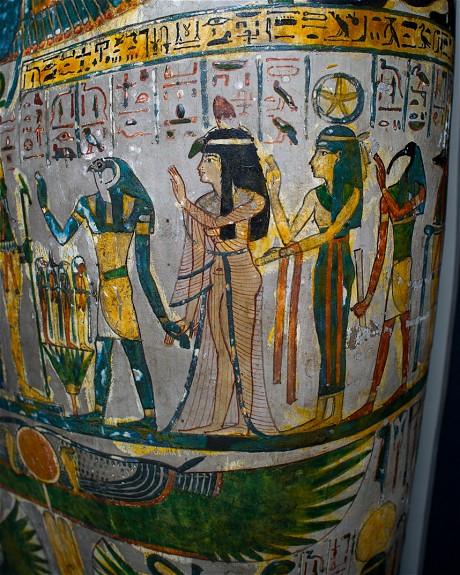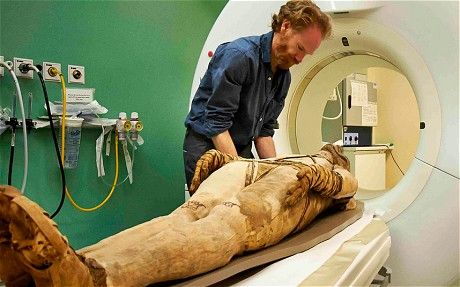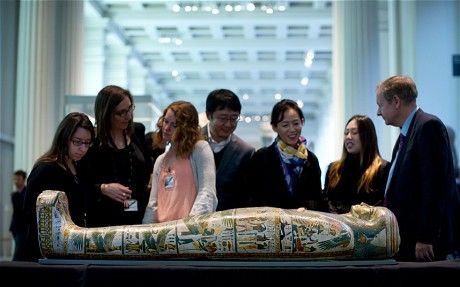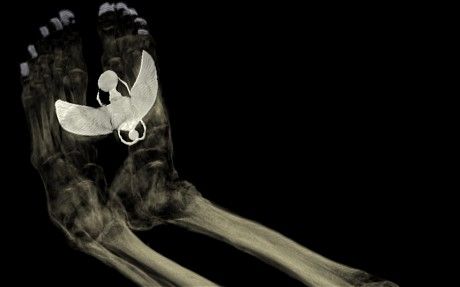The "astonishingly well preserved" Egyptian singer Tamut wore a glamorous wig, was adorned with amulets but suffered furred arteries and may have died of a heart attack
For a stylish Ancient Egyptian lady the thought of appearing in public without her wig may have proved horrifying.
But the intimate details of Tamut, a singer in a temple in Luxor, will be displayed for the first time in a groundbreaking exhibition at the British Museum, including her shorn locks.
Archaeologists have used the latest technology to scan Tamut's mummified body and discovered a wealth of new information, including that she suffered from furred arteries and may have died of a heart attack or a stroke.

© Geoff Pugh
On her exquisitely painted grave wrappings, Tamut, who lived around 900BC, is shown as a young woman with dark, flowing hair.
But archeologists found she was probably around 40 years old, with a cropped urchin-like hair cut and was suffering the effects of a poor diet.
The museum's director Neil MacGregor said technology was becoming so advanced that within five years it would even be possible to find out what her singing voice sounded like.
"Come back in another five years and you will hear Tamut sing," he said. "We'll know if she was a mezzo-soprano.
Egyptian archaeology curator Dr John Taylor, added: "This lady here once stood there singing and chanting for the God.
"She is astonishingly well preserved down to her short cut hair. She probably wore a wig as a high status individual.
"There a number of amulets lying on the front of the body. We knew that there were objects but we couldn't see them with any clarity. Now we can see them and even work out what they are made from.
"There are engraved figures of a protective eye. It's amazing we're able to recognise that on the surface. We have hopes that we may be able to read hieroglyphic inscriptions in the future without ever opening up the mummies."
)
© Trustees of the British MuseumA mummy undergoes a CT scan at the Royal Brompton Hospital
Researchers also made a more gruesome discovery when a scan of an ancient mummy revealed a spatula had been left lodged in its skull after being used to scoop out its brains.
The body of the man, from Thebes in modern-day Egypt, is believed to have been mummified around 600 BC.
Tamut and the man are among eight mummies that were examined with advanced CT scanners that produce high resolution data that can be turned into 3D images using software originally designed to make cars.
The image of the man's mummified body clearly shows the spatula in his head and a series of dental abscesses which would have caused him extremely painful toothache.
Dr Taylor added: "Even embalming didn't always go to plan. The embalmers made a mistake they introduced a rod to extract the brain down the nostrils. In this case the embalmers tool broke off and stuck inside the skull.

© Geoff PughThe mummy of the Ancient Egyptian Princess Tamut at the British Museum
"With this technology we can go inside the body and put flesh on the bones or take it away as we wish."
Mummies first entered the British Museum collection in 1756 but none has been unwrapped for the past 200 years which meant in some cases not even their gender was known.
Dr Daniel Antoine, Curator of Physical Anthropology said: "What we are now able to do is take individual slices through the body and build 3D models of the mummies and look at them with incredible clarity and detail.
"One of the things we have been able to do is to try and get a new age estimate. With Tamut she was at least in her 30s 40s or possibly older.

© Trustees of the British MuseumScan of the feet of Tamut
"We have been able to find the sex of the mummies and evidence of various pathological conditions."
The scans, carried out in a duel-energy scanner at London's Royal Brompton Hospital, also revealed that Tamut's organs had been removed, preserved and replaced in the body cavity alongside figures of Gods made from beeswax.
Mr MacGregor said: "It's a great privilege to find out what they have to tell us about life and death among the Nile.
"The museum hasn't unwrapped a mummy for a long time. We don't want to disturb them. They are human beings which actually lived.
"The way we investigate mummies is not be unwrapping but by looking underneath the bandages in a non disruptive way."
The exhibition will explore the deaths and burial practices but also the lives of the ancients with exhibits exploring themes raised by the mummies such as food and drink, medicine, music and childhood
The museum started x-raying its mummies in the 1960s and used CT scanners for the first time in the 1990s.
Reader Comments
to our Newsletter